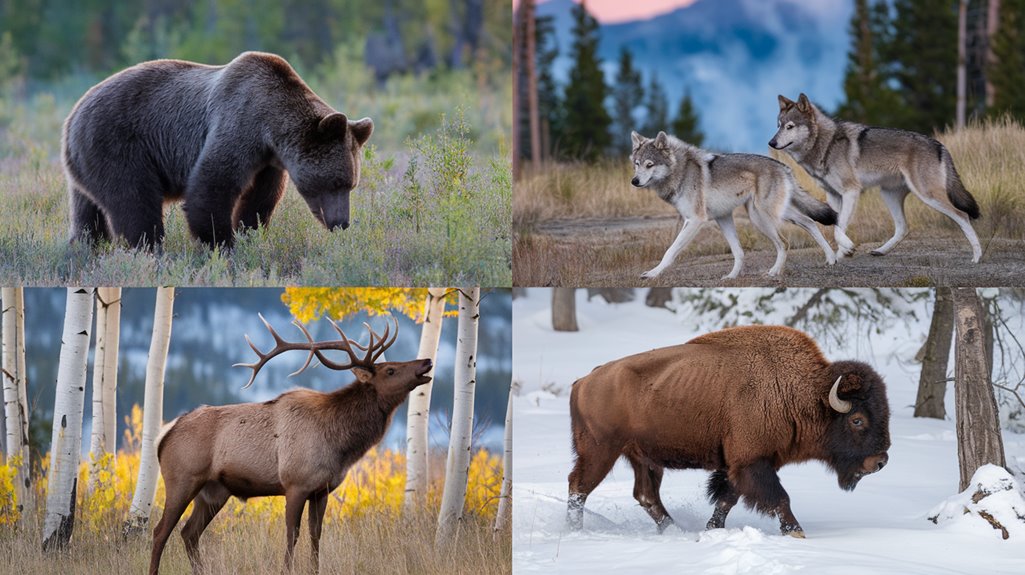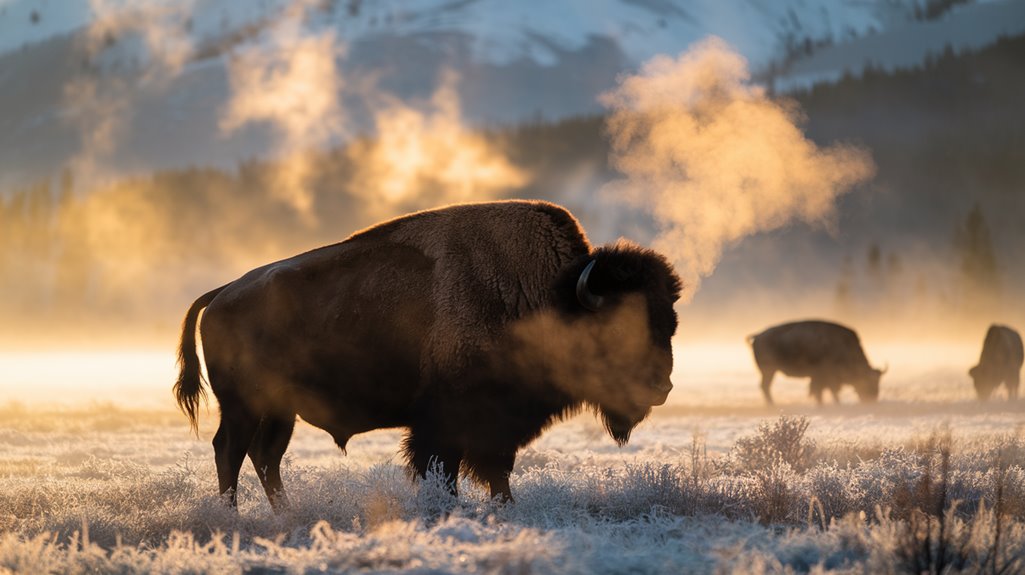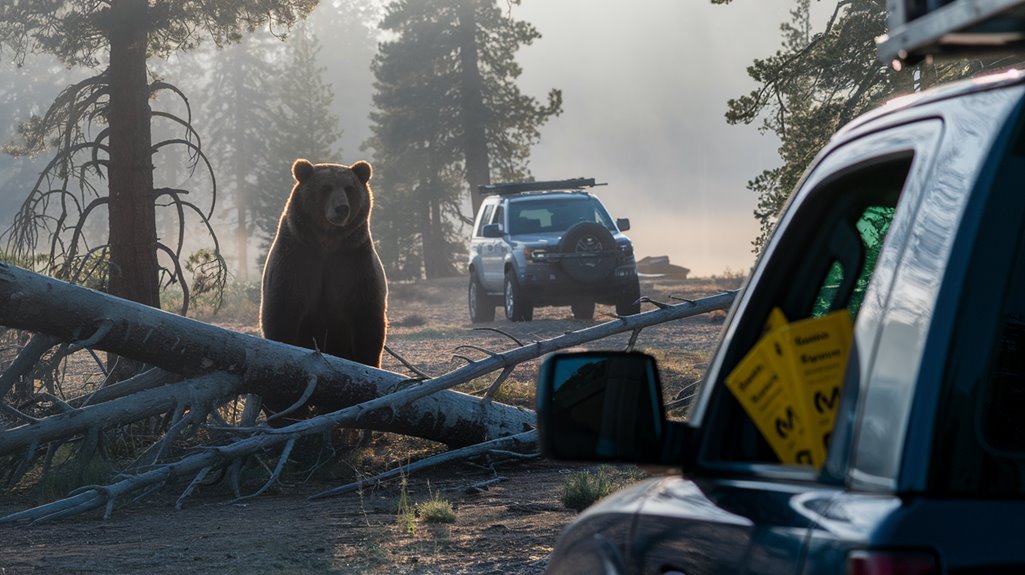You're standing in Lamar Valley at dawn, watching a pack of wolves track elk through the frost-covered meadow – a scene that plays out daily in Yellowstone National Park. While these magnificent encounters seem like rare events, you can greatly increase your chances of witnessing such moments by understanding the park's seasonal patterns and wildlife behaviors. Whether you're hoping to photograph grizzlies emerging from hibernation in spring or capture bull elk sparring during the fall rut, knowing when and where to position yourself will transform your Yellowstone journey from simple sightseeing into an unforgettable wildlife expedition.
Key Takeaways
- Early morning wildlife viewing offers optimal opportunities year-round, especially in Lamar and Hayden Valleys during dawn hours.
- Animals follow seasonal migration patterns, moving between elevations with the "green wave" of grass growth throughout the year.
- Spring and summer mornings provide chances to see baby animals with fewer crowds at popular viewing locations.
- Fall is ideal for observing elk rutting behavior and bears preparing for winter hibernation.
- Winter extends prime viewing hours into late afternoon, with animals gathering near geyser basins for warmth.
Seasonal Animal Movement Patterns
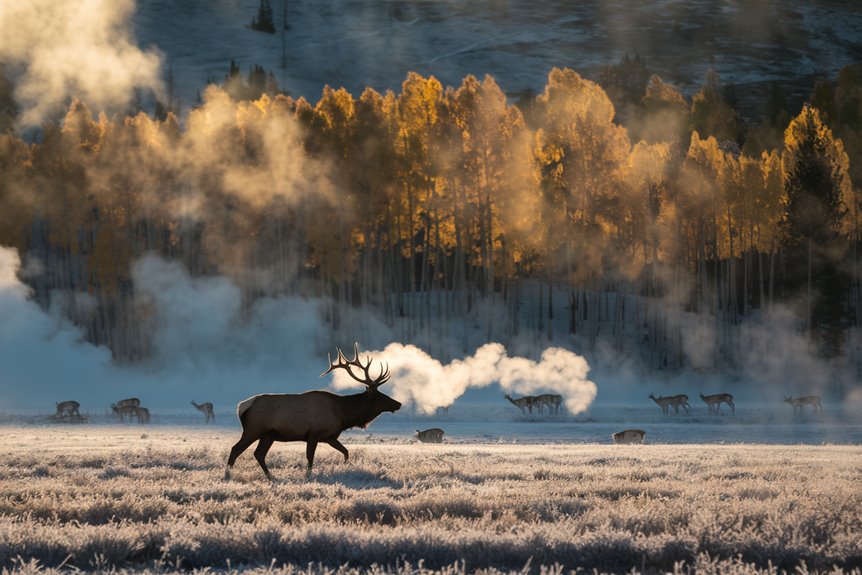
While Yellowstone's diverse wildlife can be found throughout the park, their locations change dramatically with the seasons.
You'll find elk, pronghorn, and deer following the "green wave" of grass growth, moving from lower elevations in winter to higher ground in summer. Elk migrate in thousands between the high country and valleys, while pronghorn travel over 100 miles between their seasonal ranges.
You can spot mule deer making remarkable journeys of up to 250 miles, one of the longest migrations in the lower 48 states.
These movements are essential for survival, though they're increasingly challenged by human barriers and climate change. Watch for wildlife using designated overpasses and underpasses, which help them navigate across roads and other obstacles.
Timing your visit with these seasonal patterns will enhance your wildlife viewing opportunities.
Best Times For Wildlife Watching
Throughout the day, Yellowstone presents different wildlife viewing opportunities, but early morning hours consistently provide the best chances for spotting animals across all seasons.
Dawn provides ideal conditions as animals are most active during these cooler hours, especially in Lamar and Hayden Valleys.
In winter, you'll want to extend your viewing time into late afternoon when animals become more active again.
Spring and summer mornings give you the advantage of fewer visitors and better visibility of baby animals, from bison calves to bear cubs.
Fall mornings are particularly rewarding as you can witness the elk rut and bears preparing for hibernation.
Remember to bring binoculars and maintain safe distances, regardless of when you're viewing.
For the most intimate wildlife encounters, plan your visits during seasons with fewer tourists.
Popular Wildlife Viewing Locations
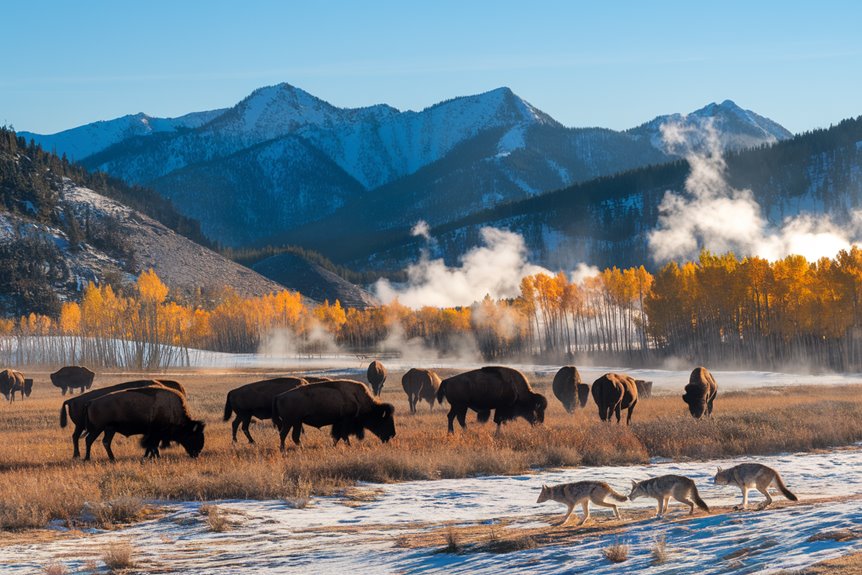
Knowing when to view wildlife is only half the equation – you'll also need to know where to look. The Lamar Valley in the northeastern corner presents prime viewing of wolves, bison, and elk, especially during dawn and dusk.
You'll find similar opportunities in Hayden Valley, where the Yellowstone River attracts diverse wildlife including pronghorns and bears.
The park's geyser basins provide unique wildlife viewing opportunities, particularly in winter when animals gather near thermal areas for warmth.
If you're interested in seeing grizzly bears, head to the East Entrance area, where they're frequently spotted near the road.
For the best chance of success, visit these locations during early morning or evening hours, when animals are most active.
Wildlife Photography Tips
To get stunning wildlife photos in Yellowstone, you'll need both the right equipment and proper technique.
For wildlife shots, use lenses in the 300-500mm range, while wide-angle lenses work best for landscapes. Consider a versatile 24-105mm or 28-200mm lens for general photography.
Frame your shots carefully, ensuring the background enhances rather than distracts from your subject. When photographing bison, overexpose by a half to full stop to capture details in their dark coats.
You'll want to practice panning for fast-moving animals and use a small depth of field to make your subject pop.
Plan your shoots around sunrise and sunset for ideal lighting. Study the park's map and animal behaviors beforehand, and be ready for winter's unique photo opportunities and summer's active wildlife during the rut season.
Essential Safety Guidelines
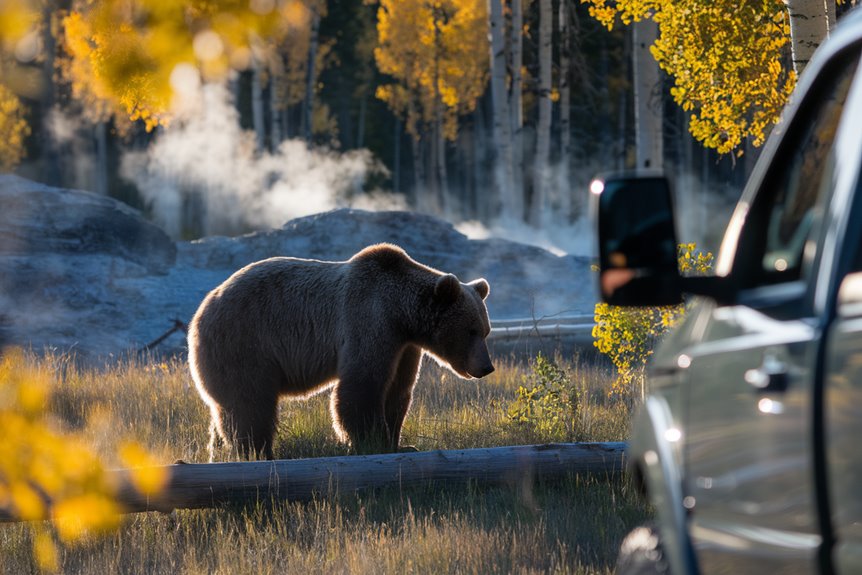
Safety comes before all else when viewing Yellowstone's wildlife. You'll need to maintain specific distances – stay at least 100 yards from bears and wolves, and 25 yards from other large animals.
Always use binoculars or spotting scopes for close-up views rather than approaching wildlife.
Keep your food secure and never feed the animals, as this can lead to aggressive behavior. When touring, stick with your group and follow your guide's instructions.
You'll want to stay on designated paths and use official viewing areas to minimize dangerous encounters. Don't stop in the middle of roads to view wildlife, as this creates hazards.
Remember to carry emergency supplies and know the proper procedures if you encounter wildlife. If you spot aggressive animals, report them to park rangers immediately.
Frequently Asked Questions
Are There Guided Wildlife Tours Available During All Seasons?
You're in luck! You'll find guided wildlife tours running all year long, with each season presenting unique viewing opportunities, from spring bear watching to winter wolf tracking.
What Special Permits Do I Need for Wildlife Viewing in Yellowstone?
You don't need any special permits for general wildlife viewing in Yellowstone. However, if you're planning commercial photography or guided tours, you'll need to obtain specific permits first.
Can Children Participate in Wildlife Viewing Activities at Yellowstone?
You can bring children aged 7 and up for wildlife viewing activities. They'll enjoy guided programs, Junior Ranger activities, safe wildlife spotting through scopes, and educational encounters with expert naturalists.
Which Entrance to Yellowstone Is Best for Accessing Prime Wildlife Areas?
Early bird gets the worm! You'll want the Northeast entrance near Cooke City for prime wildlife viewing, especially in Lamar Valley. It's less crowded and provides excellent chances for seeing bears, wolves, and bison.
Are There Wheelchair-Accessible Wildlife Viewing Locations in the Park?
You'll find excellent wheelchair-accessible wildlife viewing at Lamar Valley, with designated parking and wayside exhibits. The Mammoth area and Madison River overlooks also offer accessible spots to watch animals.
